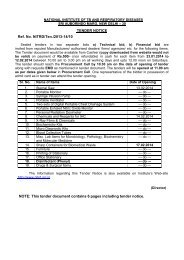October - LRS Institute of Tuberculosis & Respiratory Diseases
October - LRS Institute of Tuberculosis & Respiratory Diseases
October - LRS Institute of Tuberculosis & Respiratory Diseases
You also want an ePaper? Increase the reach of your titles
YUMPU automatically turns print PDFs into web optimized ePapers that Google loves.
GENITO-URINARY TUBERCULOSIS IN PULMONARY TUBERCULOSIS PATIENTS 233<br />
68% <strong>of</strong> the cases had bilateral pulmonary<br />
lesions as compared to 32% unilateral lesions.<br />
73% patients had cavitary lesions either unilateral<br />
or bilateral, while 27% cases were noncavitary.<br />
Maximum number <strong>of</strong> cases (68%) attended<br />
the hospital within I year <strong>of</strong> their complaints<br />
and this number gradually decreased as the<br />
duration <strong>of</strong> complaints increased (Table II).<br />
TABLE 2<br />
Showing Duration <strong>of</strong> Pulmonary Lesion<br />
SI. No. Duration <strong>of</strong> pulmonary<br />
lesion (in years)<br />
Number <strong>of</strong> patients<br />
1. 0 1 68<br />
2. 2 4 22<br />
3. 5 7 4<br />
4. 8 10 4<br />
5. More than 10 2<br />
Total 100<br />
First hour ESR was found to be raised in<br />
all cases. The range <strong>of</strong> ESR was 51-75 mm in<br />
43% and more than 100 mm in 3% cases.<br />
Frequency <strong>of</strong> urine was the commonest<br />
symptom in 29 % cases. In one patient frequency<br />
was 20-22 times in 24 hours and he was miserable<br />
because <strong>of</strong> this. Hematuria was not a conspicuous<br />
feature and was seen only in 4 %<br />
<strong>of</strong> cases. History <strong>of</strong> renal colic was present in<br />
13% cases. 18% cases had grossly turbid urine,<br />
while red coloured urine was observed in only 8<br />
cases. Acidic reaction <strong>of</strong> urine was present in<br />
18 cases, while 82% had alkaline reaction.<br />
Albuminuria was observed hi 15 cases. Microscopically,<br />
pus cells were seen in 64% cases.<br />
Microscopic hematuria was found in 15 cases.<br />
Calcium oxalate and amorphous phosphate<br />
crystals were seen in 15 cases.<br />
The urinary smears <strong>of</strong> all the 100 cases were<br />
examined for AFB and also cultured. None<br />
<strong>of</strong> the smears was positive for AFB, whereas<br />
culture could detect AFB in the urine <strong>of</strong> 6<br />
cases. All these six cases were taking haphazard<br />
anti-tubercular treatment.<br />
Urine <strong>of</strong> 51 cases out <strong>of</strong> 100, who had<br />
symptoms referrable to genito-urinary tract or<br />
had pyuria, albuminuria etc., was subjected<br />
to culture for pyogenic organism. 24 had sterile<br />
urine and in 27 cases, culture was positive for<br />
pyogenic organisms.<br />
All the 6 cases with urine culture positive<br />
for AFB had pyuria in acidic urine and the urine<br />
was sterile for pyogenic organisms. 4 cases<br />
were in the age group 15-45 years while two<br />
cases were in the age group 50-60 years.<br />
Bilateral pulmonary lesions were present in 4<br />
cases, while two patients were unilateral.<br />
Average duration <strong>of</strong> respiratory symptoms<br />
was 1½ years. Commonest genito-urinary complaints<br />
were burning sensation on micturition,<br />
increased frequency and renal colic. Renal<br />
angle tenderness was appreciable in 4 cases and<br />
thick, craggy and tender epididymis was palpuble,<br />
again in 4 cases. Out <strong>of</strong> these six cases,<br />
two did not have radiological evidence <strong>of</strong><br />
G.U.T. on IVP. while the other 4 showed early<br />
tubercular involvement <strong>of</strong> kidney as shown<br />
in Table III.<br />
Eighty seven patients were on triple-drug<br />
therapy (SM, INH, PAS or TH), whereas 13<br />
cases were on two drugs only. Isonex was being<br />
taken by 87 cases at the time <strong>of</strong> study. Most <strong>of</strong><br />
the cases (88) had been under treatment for a<br />
period <strong>of</strong> less than one year, while 12 cases were<br />
such who had taken drugs for more than 1<br />
year.<br />
Discussion<br />
In the present study, detection <strong>of</strong> AFB<br />
in the urine by culture was taken as a conclusive<br />
evidence <strong>of</strong> tubercular involvement <strong>of</strong> the genitourinary<br />
system.<br />
Regarding age and sex incidence <strong>of</strong> G.U.T.,<br />
Borthwick (1956) noted that genito-urinary<br />
involvement was rare in the extremes <strong>of</strong> age and<br />
most <strong>of</strong> the cases were seen between 16-40 years.<br />
Bayu et al (1976) had maximum number <strong>of</strong><br />
cases in the age group 30-40 years. The findings<br />
in the present series is in consonance with the<br />
above authors, 4 cases being between the ages<br />
15-45 years and the other 2 above 45 years.<br />
Out <strong>of</strong> the 6 cases having G.U.T., 5 were males<br />
and 1 female. This finding is in conformity<br />
with the findings <strong>of</strong> Borthwick (1956) who found<br />
the male/female ratio to be 2:1.<br />
Truly, tuberculosis <strong>of</strong> the genito-urinary<br />
system cannot be a primary manifestation <strong>of</strong><br />
the disease and is usually secondary to the<br />
Ind. J. Tub., Vol. XXIX, No. 4

















